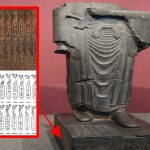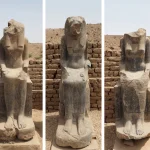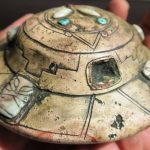In ancient Egypt, the wealthy were buried with gold sandals and toe stalls (covers) as symbols of status and to ensure comfort in the afterlife.

Egyptian finger and toe stalls are pieces of gold jewelry used to protect digits during burial. Such stalls were used during the 18th Dynasty of Egypt, as well as other eras, and were thought to protect the deceased from both magical and physical dangers, such as damage which could occur during the mummification process. Additionally, they were sometimes used in order to replace missing digits on the deceased, as it was believed that a complete body was needed for successful passage into the afterlife. This belief mirrors the myth of Osiris, whose body was put back together by his wife Isis, resulting in him becoming the first mummy.
Some mummies were buried with prosthetics which they used in life, rather than toe stalls created specifically for burial. These stalls were most commonly found on the remains of royalty. Toe stalls were discovered in the tomb of Tutankhamun, and a nearly complete set of finger and toe stalls was discovered in the tomb of three of the wives of Thutmose III in Thebes.
The wives’ jewelry is currently on display at the Metropolitan Museum of Art. The stalls from this tomb are some of the earliest known, originating from the early 18th Dynasty. A later surviving example of toe stalls comes from the tomb of Psusennes I, a 21st Dynasty ruler. Although many surviving examples of finger and toe stalls originate from the 18th Dynasty, they were used for much of Ancient Egypt, including into the Ptolemaic and Roman periods. For example, one mummy from this period was found with carved golden finger stalls, similar to those discovered from earlier periods.
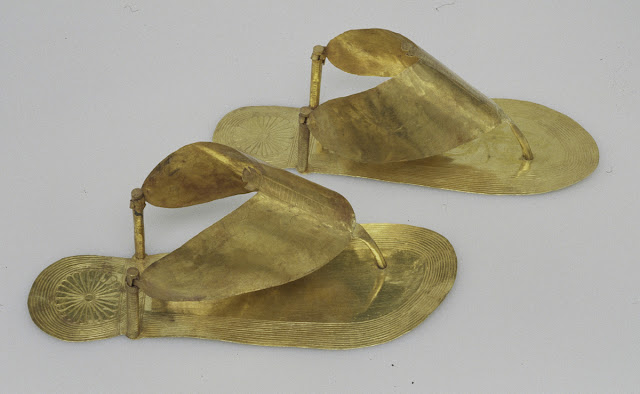
Though royalty and the upper classes typically had stalls made of gold or silver, less wealthy Egyptians utilized other materials, including wood, stone, and/or mud. In order to provide magical protection for the deceased, a prayer was made to Osiris as the stalls were created. The stalls were often highly detailed, with carved nails and other features, such as rings.
The ancient Egyptians’ burial practices were intricate and symbolic, reflecting their beliefs about the afterlife and the importance of preserving the body and soul for eternity. Among the fascinating aspects of Egyptian funerary customs is the inclusion of gold sandals and toe caps, known as stalls, in the burial attire of the deceased.
Gold held immense significance in ancient Egyptian culture, symbolizing wealth, power, and immortality. It was believed to possess magical properties that could protect the wearer in both life and death. As such, gold jewelry and adornments were common in tombs, particularly those belonging to royalty and the elite.
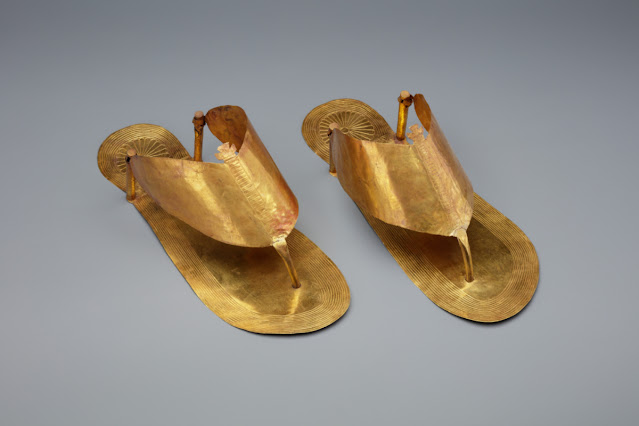
The inclusion of gold sandals and toe caps in burials served both practical and symbolic purposes. Sandals were essential footwear for daily life in ancient Egypt, protecting the feet from the hot desert sands and rough terrain. By including them in tombs, the deceased were ensured comfort and mobility in the afterlife. Additionally, gold sandals were a status symbol, indicating the wealth and social standing of the individual.
Toe caps, also known as stalls or thong stalls, were a unique feature of ancient Egyptian footwear. These ornamental pieces were attached to the sandals and covered the toes, adding an extra layer of protection and decoration. Toe caps were often intricately decorated with symbols, hieroglyphs, and images of gods and goddesses, further emphasizing their religious and spiritual significance.
The choice of gold for these sandals and toe caps was deliberate, as gold was believed to have protective properties and to be favored by the gods. The use of such precious materials underscored the importance of the deceased and their journey to the afterlife. It was believed that wearing gold in the tomb would ensure the favor of the gods and guarantee a prosperous and eternal existence in the afterlife.
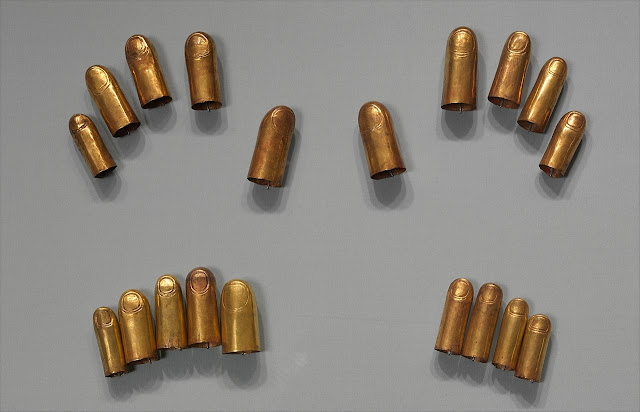
The practice of burying individuals with gold sandals and toe caps was not limited to royalty; it extended to individuals of varying social status. While the quality and intricacy of the sandals may have differed depending on the wealth of the deceased, the symbolism remained consistent. Even commoners were buried with basic sandals, reflecting the belief that everyone deserved protection and comfort in the afterlife.
Archaeological discoveries have provided valuable insights into ancient Egyptian burial practices, including the presence of gold sandals and toe caps in tombs. Excavations of royal tombs in the Valley of the Kings and other burial sites have uncovered beautifully crafted examples of these artifacts, shedding light on their craftsmanship and significance.
In conclusion, the inclusion of gold sandals and toe caps in ancient Egyptian burials highlights the importance of symbolism, status, and religious beliefs in funerary practices. These artifacts serve as a testament to the ingenuity and craftsmanship of ancient Egyptian artisans and offer a window into the spiritual world of one of history’s most enduring civilizations.
